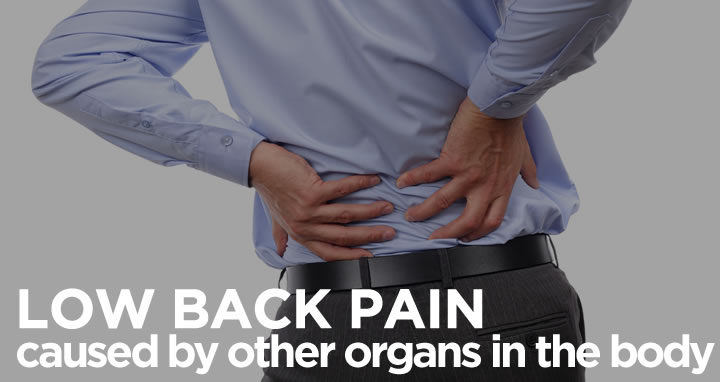
Need Help? Call 512-347-8881 or email us info@familyhealthchiropractic.com

Low Back Pain has become one of the most common reasons people visit a doctor with more than 80% of the population experiencing it in their lifetime. Back pain is so common that you can hardly find a person who has not suffered from it at least once in their life.
Low back pain is certainly a condition of modern civilization with more people sitting, staring down at their phones and hunched in front of a work station for most of the day. In fact, there are many reasons why someone can experience lower back pain and that’s exactly what we’ll be talking about in this article.
BUT FIRST… A QUICK SUMMARY (For those who don’t like to read!)
There are dozens of reasons why someone can experience back pain. However, we can categorize all these reasons into 3 main areas:
- Structural Problems and Diseases of the spine
- Female and Male Reproductive Problems
- Referred Pain due to Problems In Other parts of the body
While most causes of low back pain end up being something minor, lower back pain is certainly not something you should simply dismiss. Especially considering the fact that by the time you experience pain, damage to your body has already occurred.
So that’s the gist of this article, but if you want the details, then keep reading and we will dive deeper by getting specific on the categories discussed above.
Back Pain Due to Structural Problems and Disease of the Spine
By far, the most common cause of lower back pain is a muscle strain or soft tissue problem. This includes loss of flexibility, mobility, strength and or damage to the muscles, ligaments and tendons in and around the structures of your spine.
It’s no secret that humans are spending more and more time indoors. As a species, we were genetically selected to be running around, hunting animals, chasing deer, climbing rocks, picking berries and walking great distances every day. Today, we are sitting at workstations for several hours at a time, standing all day long on hard concrete or wood surfaces and staring at screens in poor postural positions.
Because of our daily habits and routines, we are not getting the amount of movement necessary to keep our muscles, ligaments and tendons strong, flexible and healthy. Eventually this leads to structural imbalances in our muscles and of course low back pain.
All together, these dysfunctions are known as functional cause of back pain. And when it comes to functional causes, we can further narrow it down to 4 main categories: structural imbalances, injuries, inflammatory conditions and degeneration/arthritis.
- Abnormal Posture
- Weight or Obesity Problems
- Abnormal Curvature
- Short Leg or Leg Length Discrepancy
- Muscle Imbalances
- Shortened Muscles
- Nerve root irritation
- Compression fractures
- Disc Injuries
- Tears of the muscles/ligaments/tendons
- Low back muscle strain
- Vertebral Joint Injuries
- Nerve root inflammation
- Muscle/ligament/tendon inflammation
- Inflammation of the vertebral joints
- Inflammation of the vertebral discs
- Bone infections
- Osteoarthritis
- Osteoporosis
- Degeneration of the disc
- Degeneration of the spine joints
- Primary tumor of the bones

Back Pain Due to Reproductive Problems
In addition to structural or physical problems of the spine, we also have to consider organs or systems that are in close proximity to the spine and thus could be the source of low back pain.
Sometimes conditions or diseases of the reproductive organs in the pelvis may cause lower back pain.
In women, endometriosis and fibroids in the uterus are two of the most common causes.
If endometriosis is the condition, there may be pain in the low abdominal area before or during periods, and better afterwards. Some women will have painful sexual intercourse, or pain with urination or bowel movements related to problems in the female reproductive organs.
Enlargement of the uterus due to the growth fibroids may also cause an aching or dull lower back pain by pressing on the muscles and nerves of the low back. Fibroids may cause a feeling of heaviness or pressure in the pelvic region, frequent urination, and a sometimes a sensation of rectal pressure with bowel movements. Unusually long or heavy menstrual periods are common, and may cause anemia.
Although not as common, men could also have low back pain due to their reproductive organs. For example, prostatitis, a bacterial infection, can start in the prostate gland surrounding the urethra; in one of the testes, the infection is called orchitis. The mumps virus can be the cause of an infection in the system and may result in long-lasting fertility problems.
The most common reproductive problems that cause low back pain include:
-
-
-
- Endometriosis
- Fibroids
- Prostatitis
- Trauma from gynecological operations
- Prolapse of the Uterus
- Pelvic Inflammatory conditions
- Cancerous lesions of the testes, ovaries and uterus
-
-
Back Pain Due to Other Problems in the Body
Finally, you can have low back pain that is really “referred pain” due to other problems in the body.
Many internal abdominal disorders – such as appendicitis, aneurysms, kidney diseases, bladder infections, pelvic infections and ovarian disorders, amongst others – can cause pain referred to the back.
Note that many of the following are rare, or occur in conjunction with other obvious symptoms. So if you suspect “referred pain” always check in with your doctor to rule out serious problems.
Some of the most common causes of lower back pain due to other problems (referred pain) in the body include:
-
-
-
- Kidney stones
- Cancer of the prostate
- Stomach infections
- Parasites
- Pancreatitis
- Gall Stones
- Peptic Ulcers
- Inflammation of the pelvic organs
- Occlusion of the aorta or main arteries
-
-
So there you go. We just reviewed some of the more common causes of low back pain. But what now? Let’s discuss how you can troubleshoot your low back pain.
Troubleshooting Low Back Pain, What To Do About It
Low back pain can take you out and make you call for your momma no matter how tough you think you are. So here are six ways to find out more about your condition and what is causing your low back pain:
- Get a thorough spine examination that includes X-Rays.
- Undergo a functional movement analysis to assess flexibility, mobility and strength balance of your muscles
- Get routine blood work that includes a complete blood count and inflammatory markers
- Undergo an examination of the rectum, prostate and genito-urinary organs
- Consider an ultrasound of the abdomen and pelvis
- Consider an MRI of the spine as a last resort
The first step is to rule out all the serious stuff such as cancer or bony abnormalities. This is quickly done by getting a series of xrays to evaluate your spine alignment and posture.
A through spine exam will include measuring the spine’s range of motion or your ability to move through space. This includes range of motion of your neck, mid and low back. This exam should also include a posture exam that objectively measures any postural abnormalities.
Finally, XRAY exams are a low cost and effective way to rule out serious bone lesions, cancers or growths and at the same time assess the most common cause of back pain: structural imbalances.
So start with an xray and a physician or doctor trained in biomechanics, human movement analysis and posture. Hint: , this would be done by a chiropractor ????
The second step is to have someone evaluate your functional capacity when it comes to human movement. This is an exam that measures how well your muscles, ligaments and tendons are supporting your spine. This type of analysis will include a series of tests that evaluate how well you move. It’s a simple way to evaluate flexibility, mobility and strength.
Between your xrays and functional movement assessment, you can be sure that 80% of the time you will have identified the problem. Keep in mind that correcting imbalances takes time.
However, if your low back pain continues and you’ve addressed any structural imbalances or deficiencies… the next step is to get blood work to identify if you have any infections or inflammation.
It’s also a good idea to get an examination of your reproductive organs at this time and if you’re over the age of 45, I’d recommend an ultrasound of the abdomen and pelvis to evaluate for aortic aneurysms.
Finally, if you continue to experience low back pain and or it continues to get worse, it’s time for an MRI or CT scan. But I would never start there. Generally speaking, MRI’s and CT scans do not change a doctors treatment plans or initial recommendations.
So considering the cost and amount of radiation that you get from these procedures, make sure you’ve addressed everything else and given your body ample time for recovery before jumping to this step.
In Conclusion
If you're feeling some kind of pain in your lower back region…
And now with the help of this article you have a better idea of what could be causing it and possible ways to treat it…
… It’s a good time to visit a chiropractor or physician who understands biomechanics and human movement finally solve your problem.
Remember, it’s important to identify the cause of your low back pain first, before simply covering it up with pain medications or treatment.
Not identifying the cause of your back pain and simply treating it with a band aid will surely allow the problem to continue to get worse to the point of no return.
I hope this article has served you well and If it has, please leave a comment below and lets keep this conversation going.
Got any friends facing lower back pain? Please share this post with them using the buttons below.









